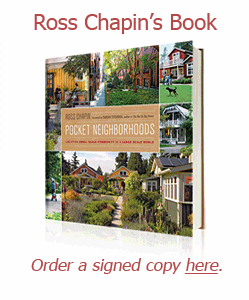|
|

Project: Conover Commons
Architect: Ross Chapin Architects
Developer: The Cottage Company |
|
Clusters of a Dozen Households
A neighborhood might contain several hundred households, but when it comes to pocket neighborhoods, we believe the optimum size is around 8 to 12 households. If a cluster has fewer than 4 households, it loses the sense of being a cluster, and lacks the diversity and activity of a larger group. When the number of households in a cluster grows beyond 12 or 16, some neighbors are too far away to be neighborly, and group decision-making becomes more unwieldy.
In communities with more than a dozen households, form multiple pocket neighborhoods, each with control of their own central common space, and connected by walkways.
Here’s a metaphor that might help to get a feel for this pattern: imagine a wedding party where guests dine in small groups, 6 to 8 to a table, and are then called together to toast the couple. In planning terms, these tables of guests are like pocket neighborhoods within a larger aggregate community. |
|

 |
The fundamental unit of organization within the neighborhood is the cluster of a dozen houses.
—Christopher Alexander, architect, builder & theorist
A Pattern Language |
|